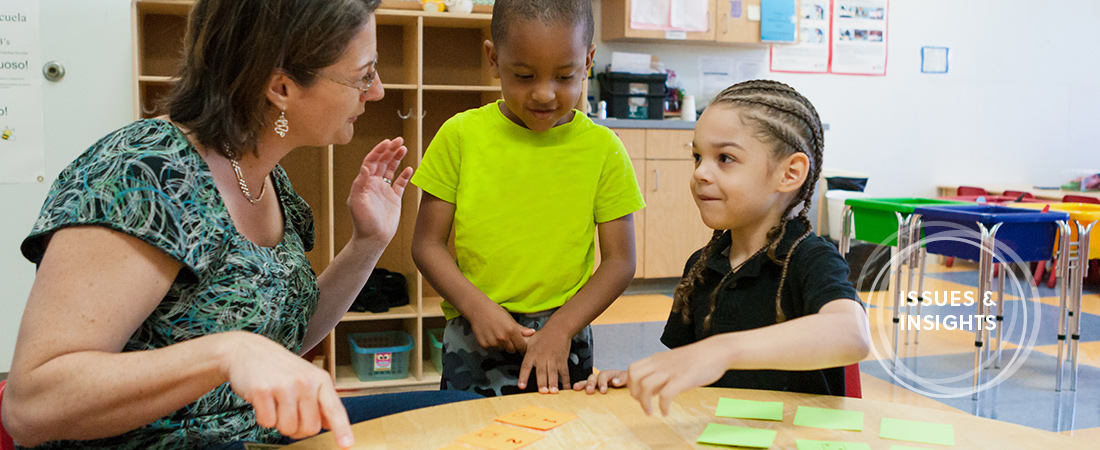The Simple Fun of Math Games

"Games allow children to explore what numbers are and what they mean," says EDC's Kristen Reed (left).
Here are more games that might be fun for preschoolers:
Playing math games with your preschooler can help build math confidence and skills that last a lifetime. For the last few years, EDC’s Kristen Reed and Jessica Young have been examining the use of math games to support early mathematics learning as part of EDC’s Young Mathematicians project. Here, Reed talks about how games can support kids’ math learning and shares a few simple games that parents can play with their children anywhere, anytime.
Q. What interests you about math games?
Reed: Games are fun and interesting for everyone, including adults. We enjoy math challenges and solving puzzles, too—that’s why supermarkets and even airport kiosks sell puzzle books. People like the feeling of figuring something out. Kids are no exception. As an elementary school teacher, I loved using the math games that were part of our curriculum. When my students played games, they were engaged, motivated, and having fun with each other—and they were also practicing math skills.
One of my favorite things to do was to ask kids about their strategies during the game: “Why did you choose that move? What else could you have done? What would have happened then?” The games provided them a way to talk about math differently. I also enjoyed seeing kids come up with new rules to make the games even more interesting for them. The games offered freedom to play with some of the ideas we were learning in the more standard mathematics lessons.
Q. What is it about games that make them so useful in teaching math skills to young kids?
Reed: Games allow children to explore what numbers are and what they mean. I think sometimes, as adults, we forget how much work goes into learning what seem to be simple math concepts, such as recognizing that a collection has nine items or understanding what a number like five means. Sometimes, we forget that children don’t automatically connect the written numeral “5” with five objects or even the spoken word “five.” Games allow a context for slowing down and exploring the concept of number.
Take a commercially available board game like Sorry. That game has tons of math. On your turn, you draw a card with a number and move one of your tokens that many spaces. Children learn that they move forward from the space their token is on—they don’t count that space again. And they practice one-to-one correspondence when they move one space for each count word. Or, if you draw a 7 card and decide to split your move, you could move one token 4 spaces and another 3 spaces. Players are practicing some math skills that are really important in kindergarten and first grade. Since the math is baked into the structure and play of the game, children get lots of practice by just playing.
Q. What other skills do games teach?
Reed: Math games and puzzles develop children’s problem-solving and independence and foster mastery motivation. Mastery motivation is the motivation to master new, somewhat challenging skills, and it is a key behavior that supports children’s early learning now, and then later, their academic success. By providing children with challenging activities and encouraging them to try different strategies and make their own decisions, teachers and caregivers can foster this important skill.
And games are social, too. Kids are interacting with and learning from their friends and their teachers when they play. We know that kids learn so much from these interactions. So aside from the mathematical benefits, there are some real attitudinal and social benefits of playing games.
Q. What are some easy, quick math games that a parent could play with a preschooler?
Reed: One of the games that I love is called “Fingers, Fingers, One, Two, Three.” To play, you put your fingers behind your back and say, “Fingers, fingers, one, two, three…how many do you see?” Then you might bring your hands in front and show three fingers raised on one hand and two fingers raised on the other. The child calls out “Five!” and then shows five on his or her own hands. You can keep doing this, changing the number of fingers on each hand and the total number of fingers you show. And the game is so simple that children can begin to play it with each other and with their families.
If you have some coins handy, you can also play “How Many Are Hiding?” For this game, you lay out a small handful of coins—let’s say five or so—and count them with your child. Then have your child close his or her eyes. Put your hand over some of the coins, ask your child to open his or her eyes, and say, “How many are hiding?” There’s nothing fancy about this game, but kids love it because it’s a puzzle—they want to figure it out. We have a lot of other games available on our Young Mathematicians website, too.
Q. You have played a lot of these games with preschoolers. How do children usually respond?
Reed: Kids love them. And their enthusiasm is infectious, so their teachers end up loving the games, too. In a lot of classrooms where we play these games, the math center becomes the most popular table. And I think that’s really what we were looking for when we designed the Young Mathematicians games. We wanted the games to be fun and social. And kids like them because they are challenging, too.